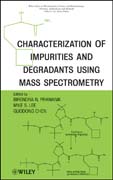
Characterization of impurities and degradants using mass spectrometry
Pramanik, Birendra
Lee, Mike S.
Chen, Guodong
INDICE: PREFACE. CONTRIBUTORS. PART I METHODOLOGY. 1 Introduction to Mass Spectrometry (Scott A. Smith, Ruth Waddell Smith, Yu Xia, and Zheng Ouyang). 1.1 History. 1.2 Ionization Methods. 1.3 Mass Spectrometer Types. 1.4 Tandem Mass Spectrometry. 1.5 Separation Techniques Coupled to Mass Spectrometry. 1.6 Prospects for Mass Spectrometry. 2 LC Method Development and Strategies (Gang Xue and Yining Zhao). 2.1 Introduction. 2.2 Column, pH and Solvent Screening. 2.3 Gradient and Temperature Optimization. 2.4 Orthogonal Screening. 2.5 High Efficiency Separation. 2.6 Conclusions. 3 Rapid Analysis of Drug Related Substances Using Desorption Electrospray Ionization and Direct Analysis in Real Time Ionization Mass Spectrometry (Hao Chen and Jiwen Li). 3.1 Introduction. 3.2 Ionization Apparatus, Mechanisms and General Performance. 3.3 Drug Analysis in Biological Matrices Using DESI and DART. 3.4 High Throughput Analysis. 3.5 Chemical Imaging and Profiling. 3.6 Future Perspectives. 4 Orbitrap High Resolution Applications (Robert J. Strife). 4.1 Historical Anecdote. 4.2 General Description of Orbitrap Operating Principles. 4.3 The Orbitrap is a 'Fourier Transform' Device. 4.4 Performing Experiments in Trapping Devices. 4.5 Determining Elemental Compositions of 'Unknowns' Using an Orbitrap. 4.6 Orbitrap Figures of Merit in Mass Measurement. 4.7 HPLC Orbitrap MS - Accurate Mass Demonstration and Differentiation of Small Molecule Formulas Very Proximate in Mass/Charge Ratio Space. 4.8 Determination of Trace Contaminant Compositions by Simple Screening HPLC-MS and Infusion Orbitrap MS. 4.9 Determining Sub-structures - Orbitrap Tandem Mass Spectrometry (MSn). 4.10 Multi-Analyzer (Hybridized) System - the Linear Ion Trap / Orbitrap for MS/MS and Higher Order MSn, n>2. 4.11 Mass Mapping to Discover Impurities. 4.12 The Current Practice of Orbitrap Mass Spectrometry. 4.13 Conclusion. 5 Structural Characterization of Impurities and Degradation Products in Pharmaceuticals Using High Resolution LC/MS and On-line Hydrogen/Deuterium Exchange Mass Spectrometry (Guodong Chen and Birendra N. Pramanik). 5.1 Introduction. 5.2 Characterization of Impurities. 5.3 Characterization of Degradation Products. 5.4 Conclusions. 6 Isotope Patten Recognition on Molecular Formula Determination for Structural Identification of Impurities (Ming Gu). 6.1 Introduction. 6.2 Three Basic Approaches to Isotope Pattern Recognition. 6.3 The Importance of Line-Shape Calibration. 6.4 Spectral Accuracy.6.5 Formula Determination with Quadrupole MS. 6.6 Formula Determination with High Resolution MS. 6.7 Conclusions and Future Directions. PART II APPLICATION. 7 Practical Application of Very-High Pressure Liquid Chromatography across the Pharmaceutical Development / Manufacturing Continuum (Brent Kleintop and Qinggang Wang). 7.1 Introduction. 7.2 Theory and Benefits of VHPLC. 7.3 VHPLC Method Develop
- ISBN: 978-0-470-38618-7
- Editorial: John Wiley & Sons
- Encuadernacion: Cartoné
- Páginas: 496
- Fecha Publicación: 28/01/2011
- Nº Volúmenes: 1
- Idioma: Inglés
